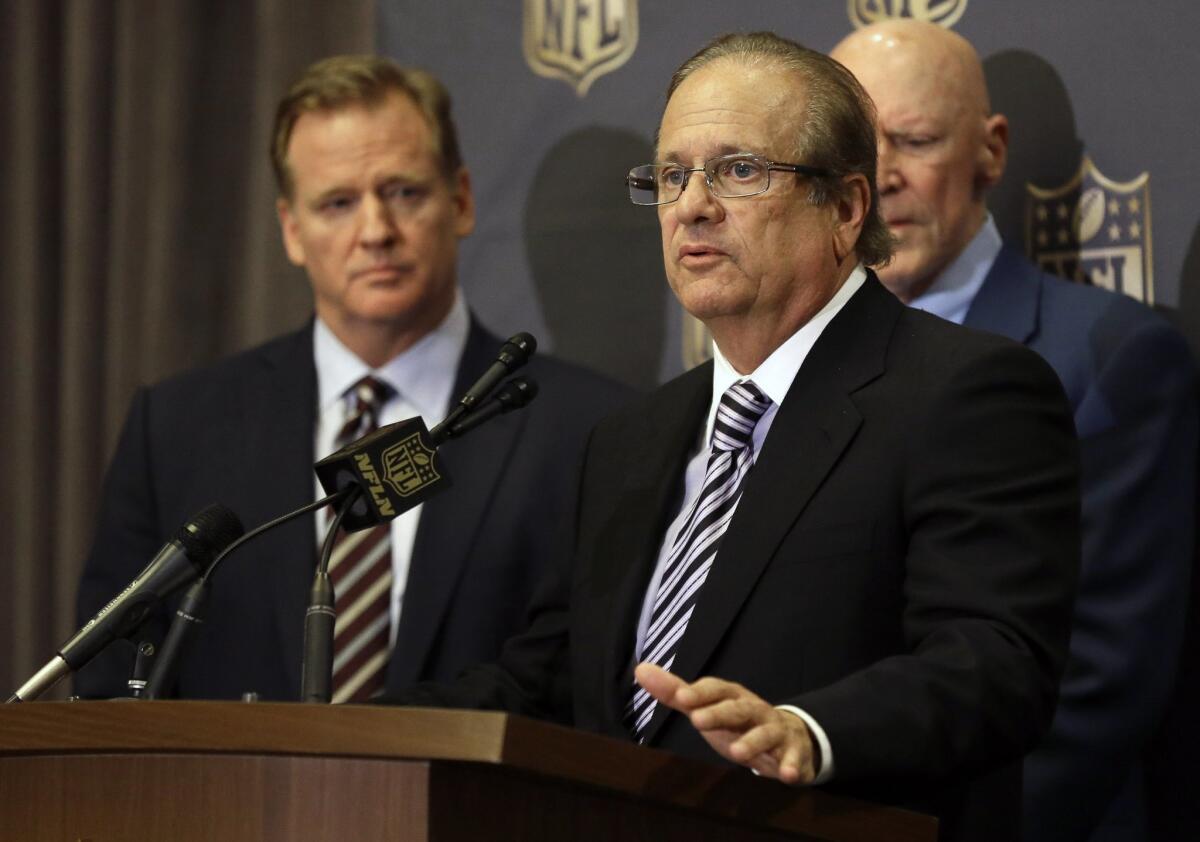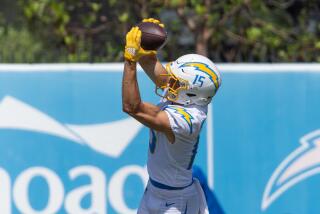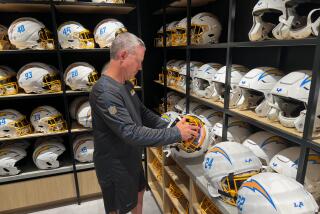Column: Chargers move is a reminder that it doesn’t pay for cities to do business with the NFL

San Diego Chargers owner Dean Spanos, center, talks to the media as NFL Commissioner Roger Goodell looks on after team owners voted in 2016 to allow the Chargers to move to L.A.
There isn’t much more to say about the San Diego Chargers’ move to Los Angeles other than: “We told you so.”
For years, we’ve been documenting how cavalier the National Football League and its franchises can be when its member billionaires’ quest for public money trumps such family values as loyalty and tradition. We’ve shown that when threats to relocate turn into reality, you can count on the billionaires to shed crocodile tears for the fans they’re leaving behind, while pledging eternal fealty to their new marks.
San Diego ... will always be part of our identity.
— Chargers owner Dean Spanos, kissing off the team’s home town
One would have thought that Rams owner Stan Kroenke (net worth: $7.4 billion, according to Forbes) set an unbeatable standard for this transparent flapdoodle a year ago, when he grew teary-eyed in front of reporters while discussing the wrenching emotional toll of moving his team halfway across the country from St. Louis to Los Angeles. He called himself a “victim” of circumstances, said, “I never dreamed I’d be put in this position,” and mooned over how bringing the team back to L.A. was the fulfillment of a dream — even though he himself had financed the original move to St. Louis in 1995.
But Kroenke has been easily matched in sanctimony by Chargers owner Dean Spanos (family net worth: $2.4 billion), who bid farewell to San Diego on Thursday with a letter assuring fans that their city, which has been the team’s home for 56 years, “will always be a part of our identity.” Yes, it will be remembered as the place where the team notched a dismal record of 416-427-11 and made it to the Super Bowl exactly once (a loss).
Spanos expressed “nothing but gratitude and appreciation for the support and passion our fans have shared with us over the years.” Then he acknowledged that in Los Angeles, where the Chargers will share quarters with the Rams in an Inglewood stadium, “we must get back to winning.”
The truth is that winning in the NFL only matters in one category — revenue. The relocation of NFL teams is never about finding a winning strategy on the field. It’s unrelated to support in the stands or providing the average fan with a better stadium-going experience.
It’s about extracting more money from taxpayers and the wealthiest members of the community, including corporations, by improving their luxury-box accommodations. The biggest chunk of income for teams comes from the leagues’ multibillion-dollar TV contracts, which are shared. So they look for revenue they can keep, which means money from stadium deals.
The best recent example of this reality is unfolding in Santa Clara, the Bay Area city that acquired the San Francisco 49ers in 2014, when it opened Levi’s Stadium. The stadium had been approved by voters based on the promise that no public funds would be required. This was a bit of a head fake, since the financing included a hotel occupancy tax — which directly hits visitors and makes local hotel rooms more expensive — and liability for public safety costs if they exceeded a certain level.
Local fans? They were almost instantly shut out of stadium attendance. Paying a one-time fee of $2,000 to $80,000 only secured the right to buy a season pass. Those would cost as much as $3,750 each, about double the price at the 49ers’ former San Francisco home, the decrepit Candlestick Park. For the average fan there were a limited number of individual tickets, including standing-room-only places.
The team was expected to collect about $100 million from season tickets, the San Jose Mercury News reported in 2014, plus $400 million from sold-out luxury suites and half the $220 million collected from Levi Strauss & Co. for naming rights to the $1.3-billion stadium. At the time, of course, the 49ers had just come off a 12-4 season in which they went two rounds into the playoffs. Since then, they’ve stunk — 8-8 in 2014, followed by 5-11 and 2-14 seasons.
Empty seats have abounded at home games this season, and the team and Santa Clara are now locked in a courtroom war. Santa Clara says it has been unreimbursed for police and fire coverage at stadium events, and that the team has failed to turn over required financial records. The team has filed a lawsuit alleging that the city’s assertions about unpaid bills are aimed at giving the city an excuse to terminate the stadium lease. The team also has asked for a $4.25-million cut in its $24.5-million annual rent, resulting from a recalculation it says was provided for in the lease to reflect actual revenue from the stadium once it began operating.
A hotel tax also was the linchpin of a Chargers ploy to get a new stadium in San Diego without spending too much of the Spanos fortune. The local hospitality industry balked, asserting that the tax would render San Diego hotel rooms uncompetitive and threaten the city’s claim on such reliable annual events as the Comic-Con convention. In November, voters rejected the proposal to raise the hotel tax to 16.5% from 12.5% to produce more than $1 billion.
By then they were understandably fed up with the team, which has been playing in the city’s Qualcomm Stadium. The city has been operating the stadium at an annual loss. In May 2015, the Spanos family turned a cold shoulder to a $1.3-billion financing plan for a replacement that would have demanded $121 million in public funding each from taxpayers of the city and county of San Diego, plus the $225-million proceeds of the sale of city land to private developers.
Fans would still be expected to fork over $100 million in the form of seat licenses and parking fees. About $173 million would come from public bonds, backed by team rent. The 60 acres of city land on which the stadium would rise was valued at another $180 million.
The family kept putting roadblocks in front of this plan, until San Diego Mayor Kevin Faulconer finally concluded that the team simply didn’t want to stay in what it seemed to consider a backwater.
NFL host cities — including Inglewood, where the Rams and eventually the Chargers will play — shouldn’t overlook the warnings implicit in these deals. St. Louis was among the communities that gained from the NFL’s trend toward moving from big cities to second-tier cities in search of lavish stadium handouts during the 1980s and 1990s. The strategy also brought teams to Indianapolis, Phoenix, Nashville, Jacksonville, Charlotte and (back to) Oakland. Only recently did the league get serious again about placing a team in Los Angeles — now two teams.
But all this moving around is just proof that the NFL doesn’t really care about any particular hometown. Every one is vulnerable, once their state-of-the-art stadiums yield to the ravages of time and fashion and the teams start whining for more money, more luxury boxes, a better deal, and then go looking around for better deals. One thing is certain even before the Rams/Chargers stadium hosts its first season openers in 2019: The NFL will eventually get tired of Inglewood too.
Keep up to date with Michael Hiltzik. Follow @hiltzikm on Twitter, see his Facebook page, or email [email protected].
Return to Michael Hiltzik’s blog.



